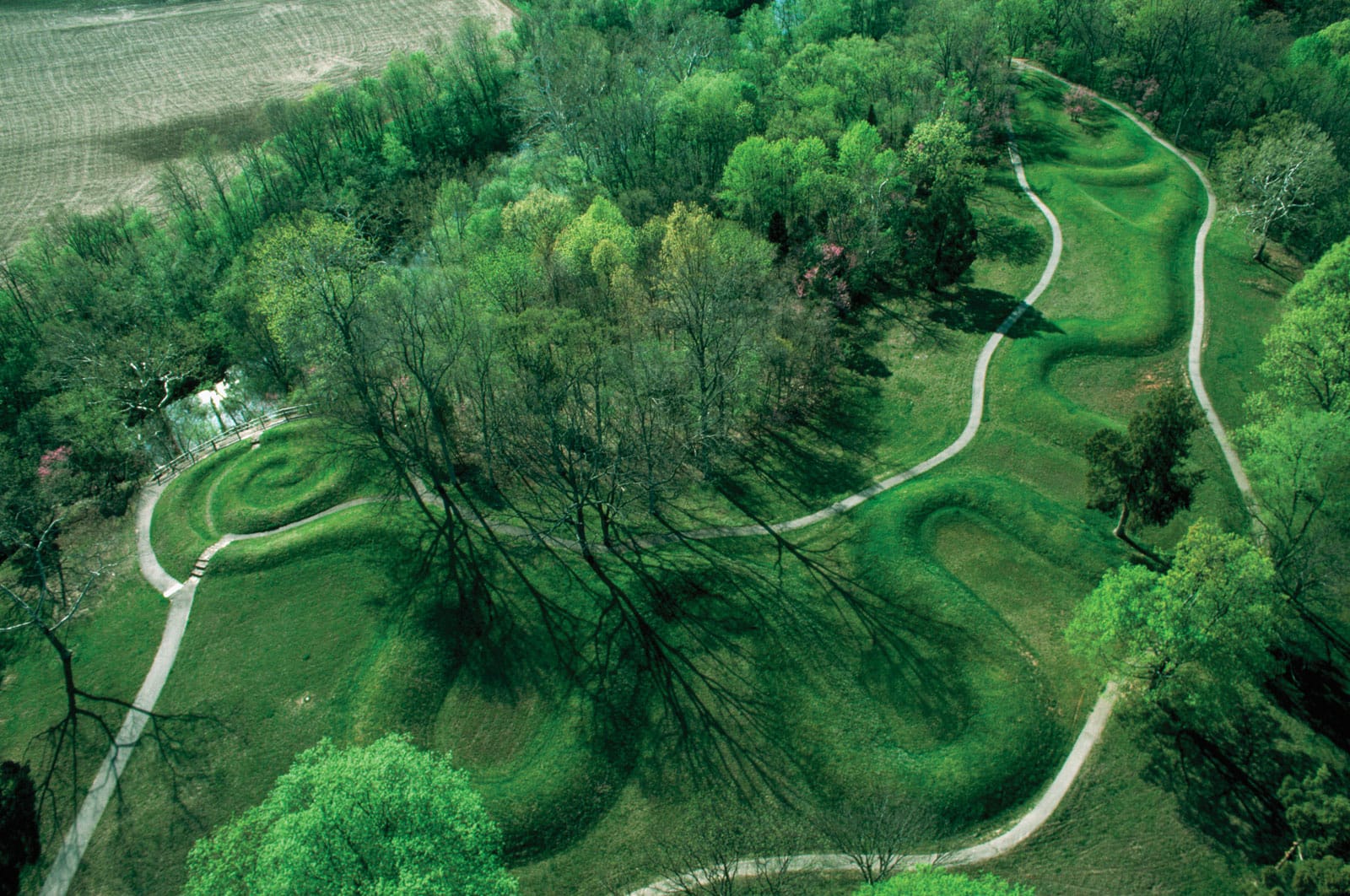Get ready to explore the amazing Serpent Mound, the biggest snake-shaped mound in the world! Nestled in the green hills of Ohio, it’s a mystery waiting to be unraveled. Our stunning photos will take you on a journey through time, revealing the secrets and stories hidden within this ancient wonder. From its sheer size to its connection to the stars and the people who made it, Serpent Mound is a fascinating puzzle that continues to captivate.
The Serpent’s Form: Dimensions and Design
Looking at photos of Serpent Mound is like stepping back in time. This visual journey takes you thousands of years into the past, to a time when ancient peoples shaped the very earth into monumental forms. Spread out over 1,348 feet (411 meters)—longer than three football fields laid end-to-end—this giant earthwork serpent, approximately three feet high and 20-25 feet wide (varying in sections), winds its way across the Ohio landscape. The tail coils in seven distinct areas, culminating in a striking triple-coiled end. The way its sinuous body conforms gracefully to the curves of the Serpent Mound crater plateau, overlooking Brush Creek, speaks volumes about the skill and vision of its builders. Photos truly capture the mound’s immensity and how it interacts with the natural contours of the land. You can almost sense the effort and artistry it took to create such a monumental work of art from yellowish clay and ash.
Whispers of the Past: Cultural and Historical Significance
Serpent Mound photos capture more than just dirt and grass; they reveal a glimpse into the beliefs and practices of the people who built this incredible structure. We don’t know for sure who created it, but theories point to either the Adena culture (800 BCE – 100 CE), known for their elaborate burial mounds and earthworks, or the Fort Ancient culture (1000-1550 CE) who lived in the area later, around the time the mound is believed to have been built (approximately 1070 CE). Who built the Serpent Mound and why? Some researchers even suggest that the mound’s shape aligns with certain celestial events, hinting at a deeper connection to the cosmos. Could it have been a place of ceremony? A giant calendar marking the seasons? The possibilities are fascinating, and each photo invites us to ponder the mysteries surrounding its creation. What happened at Serpent Mound in Ohio?
Interpreting the Serpent: Symbolism and Theories
One theory suggests the mound represents a snake, a creature often associated with power, healing, and the cycle of life and death in many cultures. Look closely at a photo of the head, and you might see what some interpret as an egg in its jaws. Could this be a symbol of rebirth or creation? Or perhaps the serpent is swallowing the sun or moon, representing celestial events. There’s no single definitive answer, which makes exploring these different interpretations even more intriguing. The presence of the mound on a ancient meteorite impact crater also raises fascinating questions about the builders’ understanding of the cosmos and their possible reverence for the site due to this celestial event.
A Legacy Preserved: Protecting Serpent Mound
Photographs of Serpent Mound also serve as a reminder of the importance of preservation. Back in the late 19th century, Frederic Ward Putnam of the Peabody Museum recognized the site’s significance and began efforts to protect it. Thanks to his work and the ongoing efforts of the Ohio History Connection, we can still visit and marvel at this ancient wonder today. Can you go inside Serpent Mound?
Capturing the Essence: Tips for Photography
Imagine visiting at dawn or dusk, the soft light casting long shadows across the serpent’s coils. Aerial photos offer a breathtaking perspective, revealing the full scale of the earthwork against the surrounding landscape. Close-up shots highlight the textures of the earth, allowing you to almost feel the ground beneath your feet. Each photograph tells a different story, inviting you to connect with this ancient site in your own way.
| Photo Type | What it Shows You |
|---|---|
| Wide Angle | The entire mound in relation to the landscape, showing its immense size and flowing form. |
| Aerial | A bird’s-eye view, revealing the serpent’s complete shape and its connection to the land. |
| Close-up | Details of the earthwork, such as the texture of the soil and the careful construction. |
| Dawn/Dusk Lighting | Dramatic shadows that emphasize the curves and contours of the mound, creating a mystical feel. |
Whether you’re a history buff, a photography enthusiast, or simply curious about the world around you, Serpent Mound offers a unique and captivating experience. It’s a place where the past comes alive, inviting us to contemplate the mysteries of our ancestors and the enduring power of human creativity. So, delve into the world of Serpent Mound photos, and let your imagination take flight. Perhaps you’ll uncover a new perspective on this ancient enigma. Who knows, maybe future research will shed more light on the secrets it holds, but for now, its mysteries continue to captivate. If you are looking for a masterpiece painting by a talented artist, Stanley Garlick painting is the right choice.
Who built the Serpent Mound and why?
We’ve established that the Serpent Mound is a pretty amazing piece of work, but the big questions remain: who built this incredible earthwork, and what was their purpose? It’s like stumbling upon a giant puzzle in the middle of a field – you can’t help but wonder about its origins and meaning.
Prehistoric Ohio saw the rise and fall of various cultures, including the Paleo-Indians, who were among the earliest inhabitants. The Adena culture, known for its complex burial rituals and earthwork constructions, later emerged, followed by the Fort Ancient culture. The Serpent Mound likely arose within this dynamic cultural landscape.
The most probable theory, based on the available evidence, is that the Fort Ancient culture were the creators of this monumental earthwork sometime around 1070 CE. These people lived in the Ohio area roughly between the years 1000 and 1550 CE. While we can’t be 100% certain, the timing and other clues strongly suggest their involvement. Imagine the effort involved: moving tons of yellowish clay and ash to shape this massive, snake-like form over 1,300 feet long! It speaks volumes about their organization, skills, and deep connection to the land.
The Serpent Mound’s location on a plateau overlooking Brush Creek, within an ancient meteorite impact crater, likely held special significance. While we don’t know for sure if the builders knew about the impact, its unique geological setting may have influenced their choice of location, suggesting the site’s perceived sacredness or a connection to celestial events.
Some experts theorize that the mound might have served as a giant astronomical calendar or observatory. Its head aligns with the summer solstice sunset, and other parts of its body seem to correspond with other significant celestial events. This suggests that the builders had a developed understanding of the movements of the sun, moon, and stars. Perhaps they used the mound to track the seasons, predict eclipses, or perform ceremonies tied to the cosmos.
Alternative theories suggest Adena influence in the design, though they likely weren’t the primary builders. The exact meaning of the serpent also remains open to interpretation, ranging from healing and protection to fertility and cosmic symbolism. Different Native American cultures, including the Shawnee who have historical ties to the region, held diverse beliefs about serpents, making it difficult to determine the builders’ specific intentions.
The mound’s sinuous form, careful placement, and possible celestial alignments hint at a rich symbolic meaning, possibly serving as a ceremonial center, gathering place, and focal point for spiritual connection.
| Possible Builders | Time Period (CE) | Evidence |
|---|---|---|
| Fort Ancient Culture | 1000-1550 | Strongest evidence based on artifacts and dating |
| Adena Culture | 800 BCE – 100 CE | Possibly influenced the design, but less likely to be the primary builders |
The story of Serpent Mound is still unfolding. Ongoing archaeological research, using new technologies, continues to refine our understanding of this fascinating place. Future discoveries may offer more insights into its creators, their intentions, and the true meaning of this ancient serpent. For now, the mound stands as a powerful reminder of the ingenuity, artistry, and spiritual depth of the people who once called this land home. It invites us to contemplate the mysteries of the past and appreciate the rich cultural heritage that continues to inspire us today.
What happened at Serpent Mound in Ohio?
Serpent Mound in Ohio, a massive earthwork shaped like a giant snake over 1,300 feet long, stands as a testament to the ingenuity of the Fort Ancient culture (11th-16th centuries CE). Built from yellowish clay and ash sometime between 1000-1200 CE, its sheer size invites questions about its purpose. The lack of written records from the Fort Ancient people has left its meaning open to interpretation, with ongoing research continually seeking answers.
Several compelling theories have emerged. The mound’s apparent alignments with celestial events, like the summer and winter solstices, suggests it might have functioned as an astronomical calendar. This may have allowed the Fort Ancient people to track the seasons, predict eclipses, or conduct ceremonies related to the cosmos.
Its location on a meteorite impact crater adds another layer of intrigue. Some believe the impact site held spiritual meaning, possibly marking a place where the earthly and celestial realms intersected. The serpent form itself carries symbolic weight in many Native American cultures, representing healing, transformation, or the earth itself, further enriching the mound’s potential meaning.
- Unlock Filipino Culture: A Deep Dive into Traditions and Practices - April 23, 2025
- Unlock Spanish Culture: Insights & Opportunities Now - April 23, 2025
- White Spirit Uses & Substitutes: A Deep Dive for Pros & DIYers - April 23, 2025
















